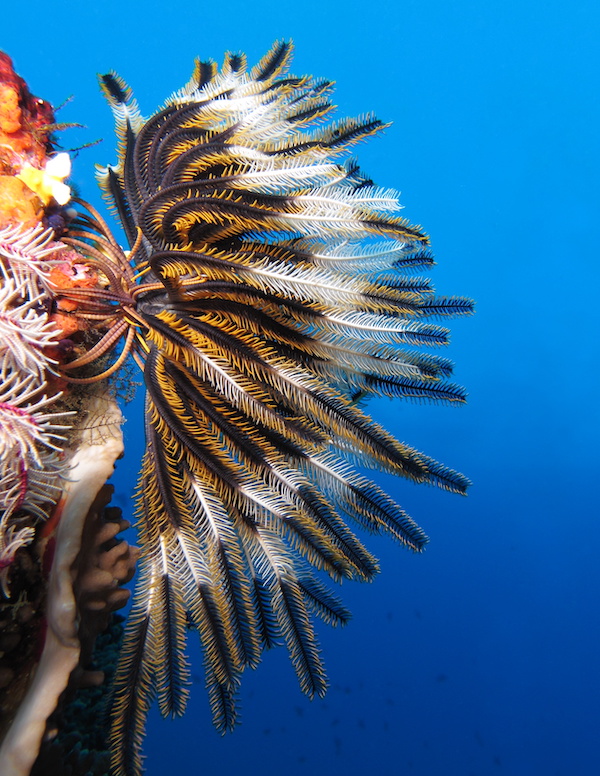Introduction
The phyla Echinodermata and Chordata (the phylum that includes humans) both belong to the superphylum Deuterostomia. Recall that protostomes and deuterostomes differ in certain aspects of their embryonic development, and they are named based on which opening of the archenteron (primitive gut tube) develops first. The word deuterostome comes from the Greek word meaning “mouth second,” indicating that the mouth develops as a secondary structure opposite the location of the blastopore, which becomes the anus. In protostomes (“mouth first”), the first embryonic opening becomes the mouth, and the second opening becomes the anus.
Deuterostome Characteristics
There are a series of other developmental characteristics that differ between protostomes and deuterostomes, including the type of early cleavage (embryonic cell division) and the mode of formation of the coelom of the embryo: Protosomes typically exhibit spiral mosaic cleavage whereas deuterostomes exhibit radial regulative cleavage. In deuterostomes, the endodermal lining of the archenteron usually forms buds called coelomic pouches that expand and ultimately obliterate the embryonic blastocoel (the cavity within the blastula and early gastrula) to become the embryonic mesoderm, the third germ layer. This happens when the mesodermal pouches become separated from the invaginating endodermal layer forming the archenteron, then expand and fuse to form the coelomic cavity. The resulting coelom is termed an enterocoelom. The archenteron develops into the alimentary canal, and a mouth opening is formed by invagination of ectoderm at the pole opposite the blastopore of the gastrula. The blastopore forms the anus of the alimentary system in the juvenile and adult forms. Cleavage in most deuterostomes is also indeterminant, meaning that the developmental fates of early embryonic cells are not decided at that point of embryonic development (this is why we could potentially clone most deuterostomes, including ourselves).
| Protostomes | Deuterostomes | |
| Phyla | Rotifera, Nemertea, Bryozoa, Phoronida, Nematoda, Platyhelminthes, Mollusca, Annelida, Arthropoda | Echinodermata, Chordata |
| Cleavage | Spiral: occurs diagonally Gaps between cells non-overlapping Determinate: Cells fated early in cell division | Radial: occurs parallel to previous cells; cells remain aligned during cell division Indeterminate: any early cell can develop into complete embryo |
| Coelom Formation | Schizocoelous: fluid filled body cavity contained within mesoderm. Solid mass of mesoderm forms during gastrulation, then splits to form coelom | Enterocoelous: fluid filled body cavity contained within mesoderm. Mesoderm layer forms in inner wall of gastrula, an outpocketing of mesoderm that grows between ectoderm and endoderm |
| Blastopore | Blastopore becomes mouth; Second opening develops into anus | Blastopore becomes anus; Second opening develops into mouth |
The deuterostomes consist of two major clades—the Chordata and the Ambulacraria. The Chordata include the vertebrates and two invertebrate subphyla, the urochordates and the cephalochordates. The Ambulacraria include the echinoderms and the hemichordates, which were once considered to be a chordate subphylum (Figure 28.46). The two clades, in addition to being deuterostomes, have some other interesting features in common. As we have seen, the vast majority of invertebrate animals do not possess a defined bony vertebral endoskeleton, or a bony cranium. However, one of the most ancestral groups of deuterostome invertebrates, the Echinodermata, do produce tiny skeletal “bones” called ossicles that make up a true endoskeleton, or internal skeleton, covered by an epidermis. The Hemichordata (acorn worms and pterobranchs) will not be covered here, but share with the echinoderms a three-part (tripartite) coelom, similar larval forms, and a derived metanephridium that rids the animals of nitrogenous wastes. They also share pharyngeal slits with the chordates (Figure 28.46). In addition, hemichordates have a dorsal nerve cord in the midline of the epidermis, but lack a neural tube, a true notochord and the endostyle and post-anal tail characteristic of chordates.
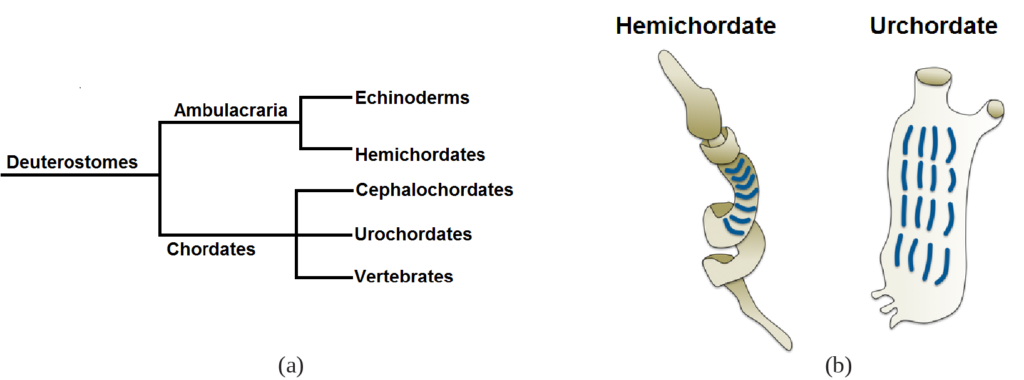
Access for free at https://openstax.org/books/biology-2e/pages/1-introduction
Echinodermata
Echinoderms are deuterstome animals that possess an endoskeleton. Echinoderms have secondarily evolved radial symmetry from an ancestor with bilateral symmetry, but often retain a bilaterally symmetrical larva. The adults are pentamerous, meaning they have 5 arms or 5 ambulacral grooves (structures associated with feeding), or multiples of five. Echinoderms are exclusively marine and can be found in most benthic marine habitats.
Adults are dioecious, with an endoskeleton consisting of calcareous plates called ossicles. As with most radially symmetrical animals, there is no cephalization. All echinoderms have a water vascular system used in locomotion, circulation & feeding. Most species have tube feet, which are extensions of the water vascular system used in locomotion, attachment & feeding. Many species also possess unique pincer-‐like structures called pedicellariae used in defense and body cleaning.
Systematics & Diversity
- Class Asteroidea -‐ Sea stars. Five or more (multiple of 5) arms radiating from a central region with an asymmetrically located madreporite (or sieve plate). Open ambulacral grooves on the oral surface with many tube feet present. Many species have pedicellariae on the aboral surface.
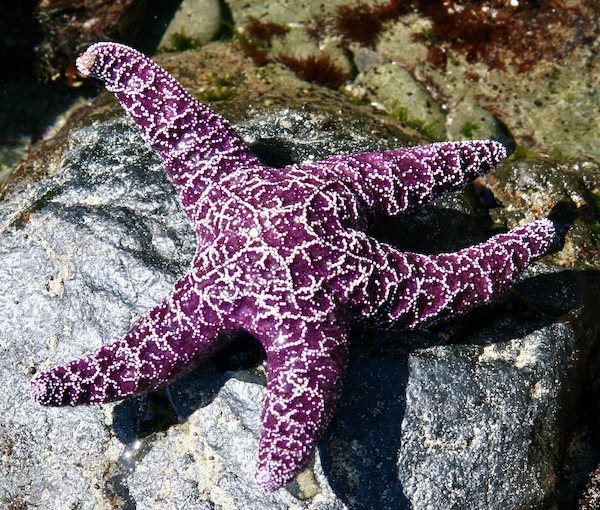
- Class Ophiuroidea -‐ Brittle stars and Basket stars. Five (or more) arms used in locomotion radiating from a distinct central disk. Closed ambulacral grooves.
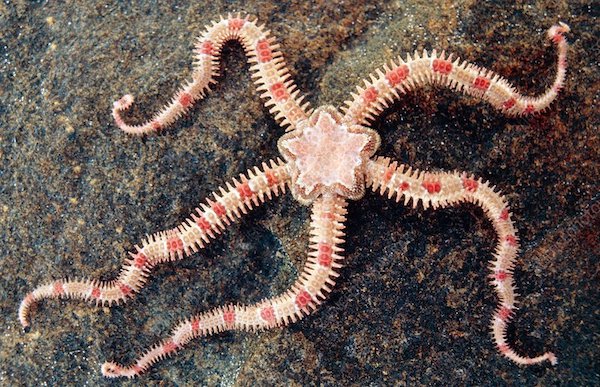
- Class Echinoidea – Sea urchins, sand dollars. Body hemispherical, with a rigid endoskeleton called a test. Mouth possesses a jaw-‐like structure called Aristotle’s lantern for chewing. Closed ambulacral grooves and numerous tube feet present.

- Class Holothuroidea – Sea cucumbers. Body elongated, forming a cucumber-‐shaped body. Tube feet present, endoskeleton highly reduced to sparsely distributed ossicles located within the body wall.
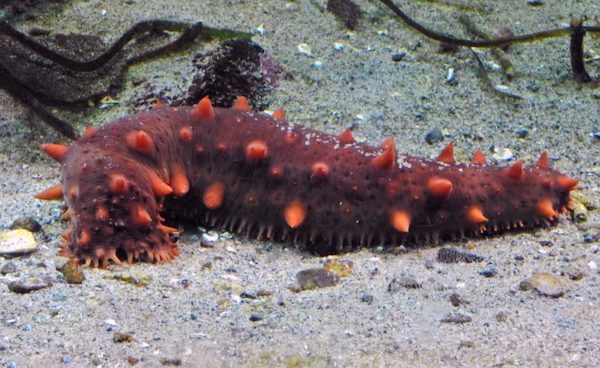
- Class Crinoidea – There is one additional class in this phylum that we will be looking at today—the somewhat rare, mostly deep sea Crinoidea, or Sea Lillies/Feather Stars.
